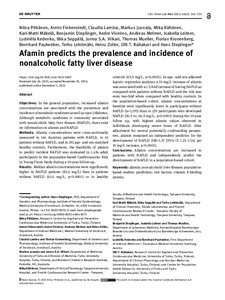Afamin predicts the prevalence and incidence of nonalcoholic fatty liver disease
Lehtimäki T; Paulweber B; Zoller H; Makela KM; Dieplinger B; Viveiros A; Kedenko L; Raitakari OT; Leitner I; Finkenstedt A; Viikari JSA; Kronenberg F; Mueller T; Dieplinger H; Melmer A; Pitkänen N; Juonala M; Seppälä I; Lamina C; Kähönen M
https://urn.fi/URN:NBN:fi-fe2022021619534
Tiivistelmä
Objectives
In the general population, increased afamin concentrations are associated with the prevalence and incidence of metabolic syndrome as well as type 2 diabetes. Although metabolic syndrome is commonly associated with nonalcoholic fatty liver disease (NAFLD), there exist no information on afamin and NAFLD.
Methods
Afamin concentrations were cross-sectionally measured in 146 Austrian patients with NAFLD, in 45 patients without NAFLD, and in 292 age- and sex-matched healthy controls. Furthermore, the feasibility of afamin to predict incident NAFLD was evaluated in 1,434 adult participants in the population-based Cardiovascular Risk in Young Finns Study during a 10-year follow-up.
Results
Median afamin concentrations were significantly higher in NAFLD patients (83.6 mg/L) than in patients without NAFLD (61.6 mg/L, p<0.0001) or in healthy controls (63.9 mg/L, p<0.0001). In age- and sex-adjusted logistic regression analyses a 10 mg/L increase of afamin was associated with a 1.5-fold increase of having NAFLD as compared with patients without NAFLD and the risk was even two-fold when compared with healthy controls. In the population-based cohort, afamin concentrations at baseline were significantly lower in participants without NAFLD (n=1,195) than in 239 participants who developed NAFLD (56.5 vs. 66.9 mg/L, p<0.0001) during the 10-year follow up, with highest afamin values observed in individuals developing severe forms of NAFLD. After adjustment for several potentially confounding parameters, afamin remained an independent predictor for the development of NAFLD (OR=1.37 [95% CI 1.23–1.54] per 10 mg/L increase, p<0.0001).
Conclusions
Afamin concentrations are increased in patients with NAFLD and independently predict the development of NAFLD in a population-based cohort.
Kokoelmat
- Rinnakkaistallenteet [19207]
